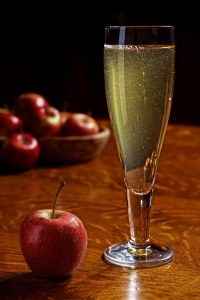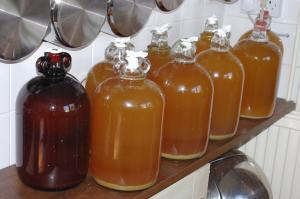This is a “getting started” guide to making hard cider for home brewers by the Minnesota Home Brewers Association. The goal of this guide is to walk you through the steps for making great hard cider and to help you learn about the decisions needed at each point in the process.
When making cider, there are many opinions as to what makes great cider, but there are three things that nearly everyone agrees are critical to keep in mind. The first is to start with good juice. The second is to use good yeast. The third is to have patience. If you start with these three items, you will have a better chance of success.

Photo by Dennis Wilkinson, Creative Commons
Terminology
Must : A term from winemaking referring to unfermented, sweet juice akin, to “wort” in brewing.
Getting started quickly
Are you looking to just get started and make some great cider? There are lots of options to consider but if you want a simple place to start, try this.
What you will need
- 5 gallons of preservative-free cider
- Campden tablet – If the cider has not been pasteurized
- Yeast Nutrient
- Yeast Energizer
- 2 Lbs brown sugar
- White Labs English Cider Yeast WLP775
- Potassium Sorbate or an extra Campden tablet
The Process
If your juice is fresh and unpasteurized then start by crushing one Campden tablet, dissolving it in some juice or water and stirring it in. Add the sugar at this point. Wait about four days before continuing.
If your juice has been pasteurized, or if you have added the Campden tablet and waited four days, oxygenate the cider, as you would unfermented wort. If you have not done so already, add the sugar at this point. Add the yeast nutrient and yeast energizer to the cider, per the package instructions. Stir to combine. Add the yeast to the cider and seal things up. Move the fermenter to a location that stays within the temperature range of the yeast, listed on the vial of yeast.

Photo by Sizbut – Creative Commons
After 3-4 days, start taking gravity readings. When the cider reaches approximately 0.010, rack to a secondary fermenter and add potassium sorbate, (per the package instructions) or one campden tablet. Move the cider to a spot as close to 33 degrees F as possible to cold-crash the yeast. Let the cider sit for about two days, then rack to a keg and force carbonate. Alternatively you can bottle the cider and enjoy it uncarbonated.
Options to consider
Just like brewing beer, there are lots of options to choose from when creating your recipe. The goal of this document is to present some common options to get you started, rather than to provide an exhaustive list of all possibilities. Here are a few common options that will come into play in this article.
Adding Sugar
Cider typically starts with a ballpark sweetness of around 1.040, (+/- 1.010). Some people want a higher alcohol level in their finished cider. To do this, add some simple sugar. Each sugar will impart its own unique flavor profile to the cider. Brown sugar is a common addition, adding about 0.010 points for each one pound of sugar added. You can use any form of sugar you like. Each type of sugar gives a slightly different flavor.
Preventing natural yeast from taking over the fresh juice
Fresh, unpasteurized, un-preserved juice will have natural yeasts in it. There may also be bacteria or other undesirable ‘bugs’ in there. There is debate about how important it is to stop these organisms before pitching your own desired yeast. Some have great experience pitching the preferred yeast right away, without any preventative action. Others suggest adding a small amount of potassium metabisulfite, commonly found in Campden Tablets. Campden Tablets should be crushed and dissolved in a bit of water or juice prior to adding to the unfermented must. Typically 1/2 to 1 Campden Tablet is used for 5 gallons. After adding potassium metabisulfate, the must needs to sit for several days to let the resulting gasses escape prior to pitching the desired yeast.
When to add yeast nutrient
Generally speaking, cider does not contain adequate nutrients for the yeast to properly and completely ferment out. To counter this, yeast nutrients are added to the cider to help provide a more desirable environment for the yeast. Typically, yeast nutrient and yeast energizer are both used. Two schools of thought exist regarding when to add these. One method is to add all the nutrient and energizer right away when you pitch your yeast. The other method suggests that you stagger the additions over three days. The first addition occurs when the yeast is pitched, the second addition occurs 24 hours after the yeast addition, and the third addition occurs 48 hours after the yeast addition. This method is referred to as a staggered yeast nutrient addition and is commonly used in making meads.
Backsweetening vs. stopping fermentation
Yeast love cider! If given the opportunity and proper environment, yeast will eat every available bit of sugar in a batch of cider, fermenting out to a final gravity below 1.000. This is typically much lower than what most people are looking for. There are two general ways to get your cider to its final gravity, or sweetness.
The first method is to monitor the fermentation by checking the gravity of the cider, stopping fermentation it when it reaches its desired sweetness. To stop fermentation, you generally will add potassium sorbate to prevent all future fermentation. After adding the potassium sorbate, you will need to force carbonate the cider if you wish to carbonate it, as the yeast are no longer able to ferment the sugar to naturally carbonate it.
The second method of reaching your desired sweetness is to let the cider completely ferment out, then back-sweeten, or add additional sugar back into the cider to bring it back up to the desired level of sweetness. With this method, one can either add potassium sorbate as above, or use temperature control to keep the yeast dormant and prevent unwanted additional fermentation. If potassium sorbate is used, force carbonation will be required. If temperature control is used, it is critical to keep the cider very cold at all times to prevent future carbonation.
How to prevent future fermentation
When your cider is at your desired sweetness you want to make sure the yeast keep fermenting it. Cold crashing is the only way to stop active fermentation. Adding potassium sorbate or Campden tablets will prevent the yeast from replicating but will not do anything for the yeast that are already alive and working. Further, sorbate does not inhibit “spoilage” organisms like lactic acid bacteria or Brettanomyces. It is not unusual for fresh (unpasteurized) juice to have lactic acid bacteria and even Brett in it. The lactic acid bacteria are a big concern because they can metabolize the sorbic acid from the potassium sorbate into a nasty crushed geranium leaf characteristic.
Traditionally, one will cold crash the cider to minimize the amount of yeast in suspension, then add sulfites in the form of Campden tablets. After a couple days, potassium sorbate is added.
Recent discussion has suggested that Potassium sorbate may not be desirable as it will produce ascorbic acid when added to alcohol, thus changing the overall pH of the cider. A discussion of this can be found in the book, The Complete Guide to Making Mead by our very own Steve Piatz!
More In Depth
Selecting your juice
If you are lucky enough to acquire fresh, unpasteurized, un-preserved cider, use it! If you can’t find fresh, look for pasteurized cider from your grocer. Be sure there are no preservatives in the juice. Preservatives will prevent the yeast from fermenting your cider, making the juice useless for fermenting. Indian Summer is typically a brand that can be found year-round that does not contain preservatives. Always check the label though to make sure.
Choosing your yeast
There many different yeast strains that will work well for cider. The resources section has some articles that describe some experiments with various yeast strains. Here are some yeast strains that come highly recommended:
- White Labs WLP775 English Cider Yeast – Retains lots of the apple characteristics while fermenting out cleanly
- Lalvin 71B-1122 Yeast – Clean, semi-dry. Enhanced fruit flavor
- Safale S-04 Yeast – Very fruity character
- White Labs WLP007 Dry English Ale Yeast
- Danstar Nottingham Ale Beer Yeast – Very fruity character
For cider, typically one vial or package of yeast is adequate for fermentation, but it doesn’t hurt to make a small starter with some juice and pitch that.
Resources
Al Boyce’s Recipe for “Beth’s Cider”
Ingredients:
- 5 Gallons Indian Summer Apple Cider
- 2 lb light brown sugar
- Yeast Nutrient, per pkg instructions
- Yeast Energizer, per pkg instructions
- Potassium Sorbate
- Oxygen
Instructions:
- Mix Cider, Sugar, Yeast Nutrient and Yeast Energizer together
- Oxygenate for 2-5 minutes (30 second bursts)
- Add yeast and swirl
- Take FG measurement starting 4th day
- Rack to keg when FG measures 1.010, or to sweetness taste
- Add potassium sorbate, per pkg instructions
- Carbonate at 30 PSI and agitate keg 3 minutes
- ENJOY!
Additional Resources
- Northern Brewer Cider Guide
- Midwest Supplies Guide
- Northern Brewer Cider Video
- HomeBrew Talk article about yeast experience
- Apples to Apples: Cider Yeast Comparison – Zymurgy Magazine, Nov/Dec 2013
Getting Started Making Hard Cider was written by Dave Royer for the Minnesota Home Brewers Association. Copyright © 2014 Dave Royer.
Getting Started Making Hard Cider by Dave Royer is licensed under a Creative Commons Attribution-ShareAlike 4.0 International License.
Based on a work at https://mnbrewers.com/getting-started-making-hard-cider/.

